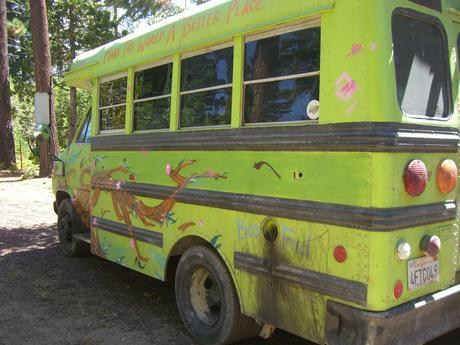 This is the final installment of the green bus series. Read all five parts here.
This is the final installment of the green bus series. Read all five parts here.
Standing as one of the most memorable and defining experiences of my life, the adventures of our green bus brought us back to Tahoe, right where we had started. From Hannibal, Missouri we continued to make a giant loop around the country, circling down South from Chicago through Ashville, North Carolina, Myrtle Beach, South Carolina, and all the way down across the northern part of Florida and through New Orleans, Austin, and Carlsbad for some cave exploration in New Mexico. In addition to meeting countless incredible people along the way and receiving numerous notes on our bus with excitement of what we were doing, some notable experiences included: attending Lollapalooza music festival in Chicago, Outside Lands in San Francisco, and Burning Man in Nevada, cleaning up an oil spill caused by burning a hole in our 50-gallon collection drum, being gifted by a stranger in Charleston a brand new Gasboy Model 60 pump when ours died, and someone donating a full tank of biodiesel to help us finish the last leg of our trip north from Los Angeles, when our filters were giving out.
All in all, we estimated to have traveled roughly 12,000 miles and recycled nearly 1,300 gallons of waste vegetable oil over the course of our summer. The knowledge gained during this trip, through pure experience, is indescribable. I walked away with a new perspective on people, on myself, and most importantly, on the entire controversy of biofuel. I realized that making a “green footprint” was much more complex than it seemed, when a whole life-cycle analysis approach was taken. I believe it is increasingly important in this age where science and technology are advancing at a faster rate than we are able to assess potential risks and damages, to be both cautious and diligent in our efforts for improvement. It is wise to keep in mind: “The pathway back from one environmental doom must not help us down another.” (Walker, 2011, sec. 6).
References:Bruckner, M. (Last Modified 2011). The Gulf of Mexico Dead Zone. Microbial Life Educational Resources at Carleton College. Retrieved December 7, 2011, from http://serc.carleton.edu/microbelife/topics/deadzone/index.html
Lovecraft Biofuels – Waste Vegetable Oil. Retrieved December 7, 2011, from http://www.lovecraftbiofuels.com/index.php?option=com_content&task=blogcategory&id=4&Itemid=76
NOAA National Weather Service. St. Louis, MO Weather Forecast Office. (Last Revised 2008). Mississippi River Flood of 2008. Retrieved December 7, 2011, from http://www.crh.noaa.gov/lsx/?n=mississippi_flood_2008#hannibal
Powers, S. E. (2005). Quantifying Cradle-to-Farm Gate Life-Cycle Impacts Associated with Fertilizer Used for Corn, Soybean, and Stover Production. Production, (May), 122. Retrieved from http://www1.eere.energy.gov/biomass/pdfs/37500.pdf
U.S. Census Bureau: State and County QuickFacts. (Last Revised 2011). Hannibal, Missouri. Retrieved December 7, 2011, from http://quickfacts.census.gov/qfd/states/29/2930214.html
Walker, R. (2011). The Impact of Brazilian Biofuel Production on Amazônia. Annals of the Association of American Geographers, 101(4), 929-938. DOI: 10.1080/00045608.2011.568885
Working Group on Biofuels of the International Panel for Sustainable Resource Management. (2009). Towards Sustainable Production and Use of Resources : Assessing Biofuels. Paris: United Nations Environment Programme. Retrieved from http://www.unep.org/resourcepanel/Portals/24102/PDFs/Assessing_Biofuels_Summary.pdf






